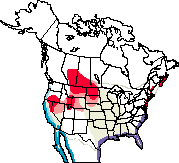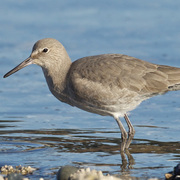Willet
General Description
The Willet is a large, chunky shorebird with drab plumage. It is similar in height to a Greater Yellowlegs, but heavier and with a shorter neck. Its bill is long and fairly thick for a shorebird, and its legs are gray. It is mottled gray all over, with heavier barring in breeding plumage than in winter. The rump is white, and most of the tail is barred gray. The wing-linings are dark, resulting in a bold black-and-white wing pattern.
Habitat
Willets in the eastern United States breed in coastal salt marshes, but the Midwestern population breeds in lakes and ponds, shallow marshes, wet meadows, and native grasslands. During migration and in winter, Willets are found near the ocean shore, in salt marshes, mudflats, sandy beaches, rocky areas, or wet meadows.
Behavior
In Washington, Willets are generally found alone or in small groups. Populations farther south often feed in large flocks. The Willet forages by walking on the shore, in a marsh or in open water. It will pick food from the water, but spends more time probing the mud with its bill in search of food. Willets are strongly territorial throughout the year, and in the breeding season will vigorously defend their nesting territories and their young.
Diet
Inland Willets eat many aquatic insects and other invertebrates. In coastal areas, crabs, mollusks, and small fish are also part of the diet.
Nesting
Willets often nest in colonies, especially along the Atlantic Coast. The nest is usually near water, but can be several hundred yards away. The nest is located on the ground, usually in dense grass. The grass is bent over to form the nest foundation, and then lined with finer grass. Both parents help incubate the 4 eggs for 22 to 29 days. The young leave the nest within a day of hatching and find their own food. Both parents defend and tend the young, but the female leaves after 2 to 3 weeks. The male remains with the young until they are independent at about 4 weeks.
Migration Status
Willets are strongly migratory. Wintering grounds include the West Coast of the United States to the north coast of South America and the West Indies. The birds wintering in Washington breed in the northern Great Plains, usually beginning by late April. Many adults depart the breeding grounds in June and July, with juveniles following soon after.
Conservation Status
Washington is at the edge of the Willet's range, and the bird is not abundant in this state. Range-wide, the Canadian Wildlife Service estimates the population at 250,000 birds in North America. Eastern populations were heavily hunted in the late 19th Century, but have made a good comeback with protection.
When and Where to Find in Washington
Small numbers of Willets winter every year in Willapa Bay (Pacific County) and on the mudflats at Tokeland, and may feed near the Raymond airport. Willets have not been known to breed in Washington, although they do breed in southern Oregon and Idaho. During migration they are rare along the coast (from mid-April to late May and from early July to mid-October) and in eastern Washington (from mid-April to late May and from mid-August to late September).
 Abundance
Abundance
| Ecoregion | Jan | Feb | Mar | Apr | May | Jun | Jul | Aug | Sep | Oct | Nov | Dec |
|---|---|---|---|---|---|---|---|---|---|---|---|---|
| Oceanic | ||||||||||||
| Pacific Northwest Coast | U | U | U | R | R | U | U | U | U | U | ||
| Puget Trough | ||||||||||||
| North Cascades | ||||||||||||
| West Cascades | ||||||||||||
| East Cascades | ||||||||||||
| Okanogan | ||||||||||||
| Canadian Rockies | ||||||||||||
| Blue Mountains | ||||||||||||
| Columbia Plateau |
Washington Range Map

North American Range Map


Family Members
 Spotted SandpiperActitis macularius
Spotted SandpiperActitis macularius Solitary SandpiperTringa solitaria
Solitary SandpiperTringa solitaria Gray-tailed TattlerTringa brevipes
Gray-tailed TattlerTringa brevipes Wandering TattlerTringa incana
Wandering TattlerTringa incana Greater YellowlegsTringa melanoleuca
Greater YellowlegsTringa melanoleuca WilletTringa semipalmata
WilletTringa semipalmata Lesser YellowlegsTringa flavipes
Lesser YellowlegsTringa flavipes Upland SandpiperBartramia longicauda
Upland SandpiperBartramia longicauda Little CurlewNumenius minutus
Little CurlewNumenius minutus WhimbrelNumenius phaeopus
WhimbrelNumenius phaeopus Bristle-thighed CurlewNumenius tahitiensis
Bristle-thighed CurlewNumenius tahitiensis Long-billed CurlewNumenius americanus
Long-billed CurlewNumenius americanus Hudsonian GodwitLimosa haemastica
Hudsonian GodwitLimosa haemastica Bar-tailed GodwitLimosa lapponica
Bar-tailed GodwitLimosa lapponica Marbled GodwitLimosa fedoa
Marbled GodwitLimosa fedoa Ruddy TurnstoneArenaria interpres
Ruddy TurnstoneArenaria interpres Black TurnstoneArenaria melanocephala
Black TurnstoneArenaria melanocephala SurfbirdAphriza virgata
SurfbirdAphriza virgata Great KnotCalidris tenuirostris
Great KnotCalidris tenuirostris Red KnotCalidris canutus
Red KnotCalidris canutus SanderlingCalidris alba
SanderlingCalidris alba Semipalmated SandpiperCalidris pusilla
Semipalmated SandpiperCalidris pusilla Western SandpiperCalidris mauri
Western SandpiperCalidris mauri Red-necked StintCalidris ruficollis
Red-necked StintCalidris ruficollis Little StintCalidris minuta
Little StintCalidris minuta Temminck's StintCalidris temminckii
Temminck's StintCalidris temminckii Least SandpiperCalidris minutilla
Least SandpiperCalidris minutilla White-rumped SandpiperCalidris fuscicollis
White-rumped SandpiperCalidris fuscicollis Baird's SandpiperCalidris bairdii
Baird's SandpiperCalidris bairdii Pectoral SandpiperCalidris melanotos
Pectoral SandpiperCalidris melanotos Sharp-tailed SandpiperCalidris acuminata
Sharp-tailed SandpiperCalidris acuminata Rock SandpiperCalidris ptilocnemis
Rock SandpiperCalidris ptilocnemis DunlinCalidris alpina
DunlinCalidris alpina Curlew SandpiperCalidris ferruginea
Curlew SandpiperCalidris ferruginea Stilt SandpiperCalidris himantopus
Stilt SandpiperCalidris himantopus Buff-breasted SandpiperTryngites subruficollis
Buff-breasted SandpiperTryngites subruficollis RuffPhilomachus pugnax
RuffPhilomachus pugnax Short-billed DowitcherLimnodromus griseus
Short-billed DowitcherLimnodromus griseus Long-billed DowitcherLimnodromus scolopaceus
Long-billed DowitcherLimnodromus scolopaceus Jack SnipeLymnocryptes minimus
Jack SnipeLymnocryptes minimus Wilson's SnipeGallinago delicata
Wilson's SnipeGallinago delicata Wilson's PhalaropePhalaropus tricolor
Wilson's PhalaropePhalaropus tricolor Red-necked PhalaropePhalaropus lobatus
Red-necked PhalaropePhalaropus lobatus Red PhalaropePhalaropus fulicarius
Red PhalaropePhalaropus fulicarius

